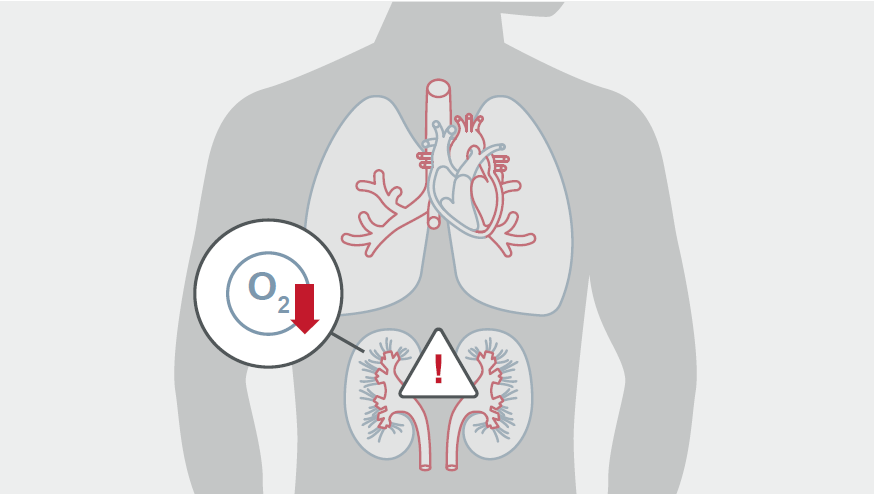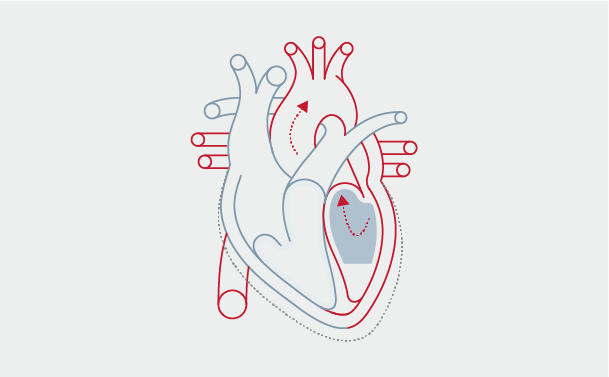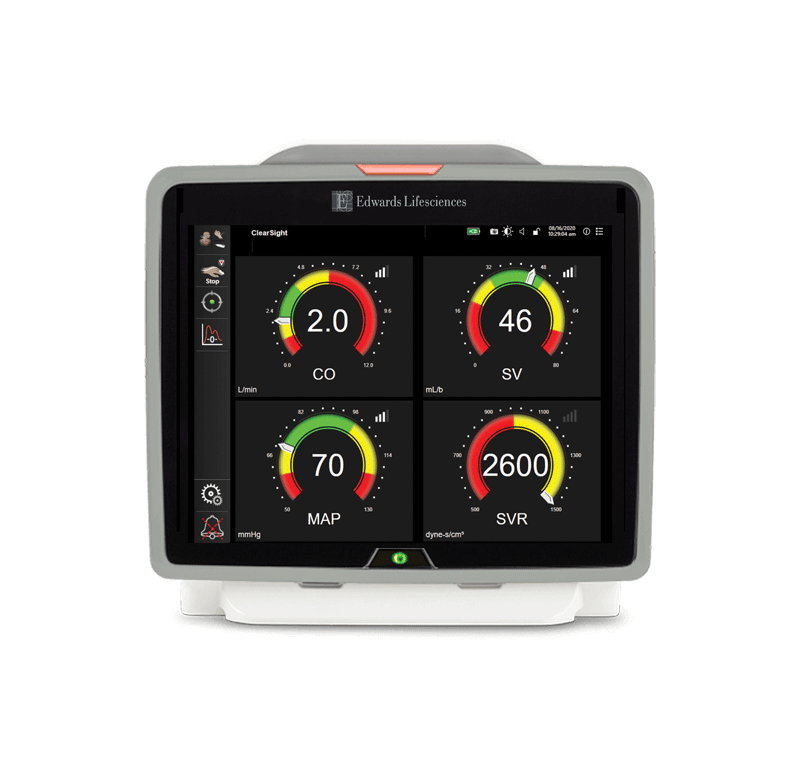
Le choc est fréquent.
Un tiers des patients en USI souffrent d’une forme de choc.3,4


L’état de choc, à son niveau le plus basique, correspond à un apport insuffisant d’oxygène aux tissus, qui dépendent de la perfusion, de la pression (MAP) et du débit.1


Un tiers des patients en USI souffrent d’une forme de choc.3,4

Les patients des USI présentant un choc ont un risque de décès de près de 40 %.3
Cet état mortel se manifeste par une hypotension, une hypo-perfusion et des lésions organiques.4

Il a été démontré que l’indice de choc modifié (MSI) est un facteur prédictif de la mortalité hospitalière chez les patients gravement malades ou blessés. Il existe d’autres indices qui peuvent également être utilisés pour identifier les patients à risque. Indices courants :

L’une des raisons principales de l’utilisation de paramètres hémodynamiques avancés pour les patients en état de choc est d’identifier le type de choc afin de déterminer la thérapie la plus appropriée.
Une identification rapide est essentielle pour pouvoir commencer une prise en charge agressive. Un traitement approprié repose sur la compréhension des mécanismes physiopathologiques sous-jacents.4
Il existe quatre principaux types de chocs : 2,4




Des études montrent que les personnes soupçonnées de souffrir de maladies similaires (comme l’insuffisance cardiaque, le sepsis et l’accident vasculaire cérébral) présentent des profils hémodynamiques très différents.8
Les tendances des paramètres avancés fournissent des renseignements sur le type de choc sous-jacent et permettent aux cliniciens de traiter plus efficacement le type de choc spécifique.

Un soutien hémodynamique précoce et adéquat des patients en état de choc est crucial pour prévenir l’aggravation du dysfonctionnement et de la défaillance des organes4.
La correction de l’hypotension artérielle est essentielle pour rétablir la pression artérielle et assurer un métabolisme cellulaire adéquat, ce qui est l’objectif principal de la réanimation.
Après correction de l’hypoxémie et de l’anémie sévère, le débit cardiaque (CO) est le principal déterminant de l’apport d’oxygène, et il est également essentiel d’obtenir un CO compatible avec la perfusion tissulaire.
Les mesures de la saturation en oxygène du sang veineux mêlé (ScvO2, SvO2) peuvent également être utiles pour évaluer l’adéquation de l’équilibre entre la demande et l’apport en oxygène4.



Les mesures continues et les paramètres hémodynamiques avancés peuvent être utilisés pour surveiller le patient gravement malade et fournir des renseignements supplémentaires par rapport aux paramètres traditionnels comme la CVP, la HR et la perte de volume estimée uniquement.1 Les situations de choc peuvent s’aggraver rapidement et la surveillance hémodynamique avancée fournit des renseignements qui vous permettent de prendre des décisions cliniques proactives en connaissance de cause.
Les mesures hémodynamiques, comme celles fournies par le système ClearSight, le capteur FloTrac, le capteur Acumen IQ ou le cathéter Swan-Ganz fonctionnant avec une plate-forme de surveillance avancée, peuvent vous donner un aperçu de la fonction cardiovasculaire d’un patient afin de guider la prise de décision.
Chez un patient en état de choc, il est important de surveiller la pression artérielle pour détecter une éventuelle hypotension. Un événement hypotensif peut être défini comme une MAP < 65 mmHg pendant au moins une minute. Une pression artérielle inférieure à ce seuil peut augmenter le risque de mortalité et de défaillance des organes.1
Le logiciel Acumen Hypotension Prediction Index (HPI) est une technologie unique en son genre qui détecte la probabilité qu’un patient présente une tendance à l’hypotension avant que celle-ci ne survienne. Il vous fournit des renseignements qui vous permettent de comprendre l’origine et de définir un plan d’action potentiel pour votre patient. Pour en savoir plus, visitez le site Edwards.com/HPI.

La thérapie par fluides visant à augmenter le débit cardiaque est un élément essentiel du traitement de toute forme de choc et doit être étroitement surveillée4.

Précharge : tension des fibres myocardiques en fin de diastole, résultant du volume du ventricule

Volume d’éjection systolique (SV) : volume de sang pompé par le ventricule gauche à chaque battement de cœur
La mesure du volume d’éjection systolique avec les dispositifs Edwards, comme le manchon de doigt ClearSight, le capteur FloTrac et le capteur Acumen IQ, permet une approche individualisée de l’administration de fluides jusqu’à ce que le SV atteigne un plateau sur la courbe de Frank-Starling afin d’éviter l’hypovolémie et l’administration excessive de fluides.
Les paramètres hémodynamiques avancés, comme le SV et la variation du volume d’éjection systolique (SVV), sont essentiels à l’administration optimale de fluides et au maintien des patients dans la plage volumique optimale. Ils sont plus instructifs que les paramètres conventionnels (comme la pression artérielle ou la pression veineuse centrale) pour déterminer la réactivité aux fluides et peuvent aider les cliniciens à éviter une administration de fluides excessive ou insuffisante.

Lors de la gestion de la perfusion, le volume d’éjection systolique peut être optimisé en utilisant la courbe de Frank-Starling du patient, un tracé du SV en fonction de la précharge.

Avec le capteur FloTrac, le capteur Acumen IQ ou le système ClearSight, l’emplacement du patient sur sa courbe de Frank-Starling peut être déterminé en mesurant le ΔSV en réponse à la modification de la précharge à l’aide d’une épreuve de remplissage (bolus de fluides) ou d’un lever de jambe passif.
Pour les patients sous ventilation contrôlée, le SVV est un indicateur très sensible et spécifique de la réponse à la précharge, et sert de marqueur précis de l’état du patient sur la courbe de Frank-Starling.

Edwards propose une gamme de solutions d’aide à la décision clinique qui fournissent des paramètres hémodynamiques avancés utilisés dans la prise en charge des patients gravement malades.
Chez Edwards, nous mettons tout en œuvre pour offrir à votre établissement, à vos cliniciens et à votre personnel un soutien et un service après-vente irréprochables, afin de garantir une installation harmonieuse et un fonctionnement ininterrompu de vos produits, notamment :
Un support technique 24 h/24 et 7 j/7
Pour obtenir des renseignements sur les produits et les commandes
